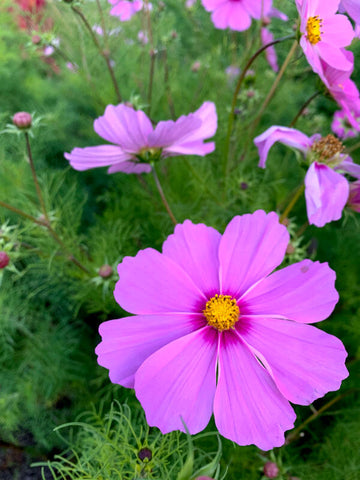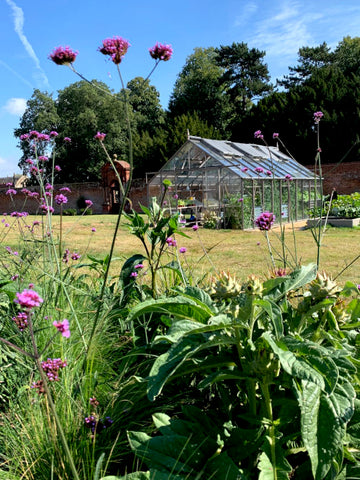Yesterday, I returned to the gorgeous grounds of Ketteringham Hall, to partake in another course with Norfolk School of Gardening, this time under the tutelage of Sarah Hammond of English Peonies.
4 Things I can always rely on when I go to Norfolk School of Gardening:
- Homemade Biscuits
- Excellent Teachers
- Inspiration
- Freebies
Growing Your Own Cut Flowers
As you might imagine, Sarah of English Peonies is a flower fanatic. She has her own walled garden on her family farm a mile out from the coast, where she grows a gorgeous variety of flowers for cutting and arranging. Her mother did the same before her, with her flowers being taken all the way to Covent Garden, and Sarah is very happy to continue the tradition.
So, first things first, some sit-down learning with a good old fashioned PowerPoint presentation (if such a thing can be called old-fashioned) and some of Ruth's homemade biscuits (1. Homemade Biscuits - Tick). Sarah is an expert and is a filled with top tips for all things petalled, and made certain to take the needs of the group into account (2. Excellent Teachers - Tick). As always, the classes are a smorgasbord. The group included an ecologist, a B&B owner, and, quite by coincidence, two prospective Rhino owners! - Sarah being one of them.

Taking into consideration the desires of the group, we talked a lot about containers - which is good for me, not having a garden of my own. The consequence however, was to leave me with a burning desire to go out and buy my bulbs and seeds immediately (they're now on their way to me in the post) (3. Inspiration - Tick). No matter what your own limitations, there is always an emphasis on being imaginative with what you have. As part of the class, we spent some time looking through seed catalogues and books for inspiration on what we could do in our own gardens (or minuscule balconies, in my case).
It's very easy to get overwhelmed with the options, but gardening is easier than people think. While there are some rules to follow, they are often bent - whether consciously or not - and nature proves itself resilient time and time again. What's the worst than can happen? You try again next year.
My Cut Flower Container Criteria
One of the most useful things about going to these days at Norfolk School of Gardening, is that it gives you ideas. You might arrive with none, but you'll leave with plenty. When you flick through seed catalogues, the choices can be overwhelming; when you scroll through Pinterest, you might have no idea how to recreate the wonderful display you've come across. But the key for most of us is to work with what you've got and just do what you love. By the end of the day, I had a list of criteria for my containers, a list of plants that would work and colours I wanted to use.
- Unscented - I have a strong sense of smell and also suffer from hayfever. I am consequently quite sensitive to strongly scented flowers. Thankfully, it is possible to still enjoy flowers, by selecting varieties with little to no scent attached to them. I remember my mother having vases of lilies in the house and my father and I heading to the opposite end of the house to escape the ensuing headache that accompanied their presence. So, no scent please!
- Low Pollen - Another decision driven by hayfever.
- Perennial Plants - I'm working with a small budget and limited spare time to tend to my plants. So I want to include as many perennial plants as I can, so it will continue to provide blooms in the years to come.
- Winter and Spring Colour - I love flowers, but rarely buy bunches from supermarkets, so I want a way to keep flowers growing in my home through the gloomier months. Luckily for me, that is made possible by the many varieties that can be grown through the winter. And even if they aren't flowering immediately, I can at least be comforted in the knowledge that I can nurture seedlings that will bloom soon.
- Short Stems - You don't have to go short if you're using a container - there are some very tall containers out there! But I don't have the luxury of space, so I want to keep my plants within reasonably short dimensions. I'm also saddened by leggy tulips, made floppy by circumstance. So hopefully, by choosing shorter flowers, I'll avoid the drooping.
These are the stipulations I came up with, and you can use the same principles to come up with your own.
So, how will I achieved this?
Bulb Lasagne - Layered Planting
Layering is very important when planting your flowers. For starters, you must plant the tallest things at the deepest depth. This means they'll grow up stronger and be more likely to support themselves once they really get going.
The depth of a seed or bulb will generally be around 2-3 times its own height. You can leave a comfortable layer of compost between layers of bulbs, and trust that they will find their way around each other, when its time for them to emerge. And while you're waiting for them to grow, you can grow something shallow in the topsoil, to give you interest in the interim. I would previously have been worried about layering seeds and bulbs in this way, for fear the different layers would suffocate or dislodge one another. But it turns out, I needn't have been worried! Sarah recommended a useful YouTube video, to demonstrate how one might plant up a container of spring bulbs.
So my container will be layered something like this:
Deepest
Daffodils
Narcissus
Crocus
Winter Pansies
Shallowest
All of my seeds have just been ordered, and I'm very excited. Although I should probably go and buy a container too...
If you're very lucky, you might have your own flowers to harvest seeds from now.
Seed Harvesting
September weather being its unreliable self, we arrived on Tuesday morning under dreary clouds, but were basking in sunshine by the time it was time to go outside. And what a glorious place Ketteringham Hall is to enjoy the last of the sunshine. While I'm sure the majesty of the grounds persists through the colder seasons, it is something particularly special to behold when all the summer flowers are in bloom.

And we, much like all the other insects in the garden, made a beeline for the colourful tumbles of shrubbery. In a series of beds, in the far corner of the walled garden, between the roasting hot polytunnel and the somewhat cooler Rhino Greenhouse were plants heavy with flowers and seedheads. Some show and tell first, and then some plundering.

Starting with a tour of the flower beds, seeing what is still flowering and what you are likely to expect from them as the year progresses. Some of the plants were already ready to give up their seeds, and Ruth was only too happy to pass round the natural treasures (4. Freebies - Tick). It is also worth noting that any plant that is producing seed heads now, is essentially preparing to self-seed, so now is the exact time to sow those same seeds yourself.
If you want to, leave some seed heads behind, to keep interest for the colder months. Some flowers leave behind stunning structural stems, like aliums and poppies. Although, be careful of leaving too many; you might have an invasion on your hands, come next summer.
We were able to to pick a selection of seeds to take home, along with a range that Ruth brought in from her own garden. Laid out in the polytunnel was the most mature version of a Pick 'n' Mix you've ever imagined. Printed pictures and labels next to each paper bag teaming with seeds.
"Everyone grab a few envelopes and fill them with whatever you'd like!"

My goody bag included Orlaya, Cosmos, Ranunculus, and some others I can't name off the top of my head (I don't have a memory for plant names yet).
Autumn is only just beginning; plenty more flowers will go to seed very soon, so you can keep on plundering your flowerbeds for a while yet. September 23rd - October 23rd is national Seed Gathering Season, a campaign run by the Tree Council. They host events and talks through the season, to encourage everyone to get more involved in nature.
Sowing Now & Flower Forcing
As mentioned previously, any plant that is self-seeding now is ready for you to sow too. Once we had made our selections in the polytunnel, we did a bit of propagating inn the Rhino Greenhouse. It wouldn't be a gardening course if you didn't get your hands dirty.

There is now a little compostable tray on my balcony at home, soaking up what remains of the sunshine, so I'll have some seedlings for overwintering.
However, it is possible to force some plants to flower out of their natural season - people do love to have flowers for Christmas. This is what makes it possible for supermarkets to sell certain varieties all year round. And it is possible to achieve this affect at home. In essence, you fool the seeds or bulbs into believing it's winter already. Keep them in a cool, dark place - one person said they keep bulbs in shoe boxes under the bed - simple enough really. This encourages the plant to prepare for what they think is spring approaching, so when they are finally exposed to light, warmth and water, they start sprouting.
Pop your bulbs into a container with a layer of compost, but leaving a third of the bulb exposed. Leave them in a cold, dry, dark place and wait for spikes to start appearing. When they do, it's time to bring them out and give it an artificial spring welcome. Keep it in a warm, brightly lit location and keep the soil moist, to mimic spring showers. Depending on the plant, it will take 1-2 months to start flowering, so if you want them for Christmas, plan accordingly.
I'm not going to be able to do this myself, but I would be fascinated to know if anyone else gives it a go!
Then there was just enough time to stand back and admire the Rhino Greenhouse...


That concludes my most recent day with Norfolk School of Gardening. I had a lovely day, and can't wait to plant up my container!




